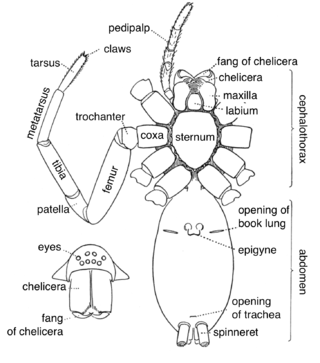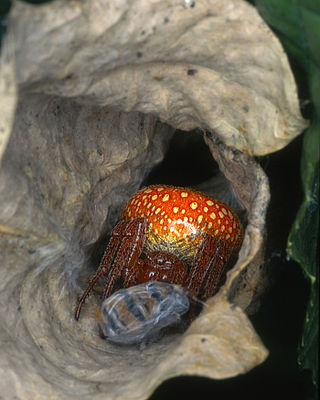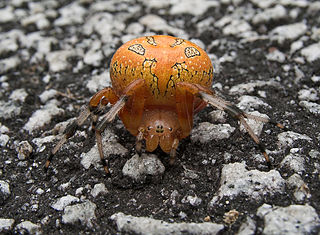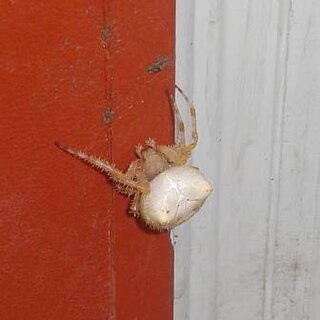
The spider species Araneus diadematus is commonly called the European garden spider, cross orbweaver, diadem spider, orangie, cross spider, and crowned orb weaver. It is sometimes called the pumpkin spider, although this name is also used for a different species, Araneus marmoreus. It is an orb-weaver spider found in Europe, where it is native, and North America, where it was introduced.

The epigyne or epigynum is the external genital structure of female spiders. As the epigyne varies greatly in form in different species, even in closely related ones, it often provides the most distinctive characteristic for recognizing species. It consists of a small, hardened portion of the exoskeleton located on the underside of the abdomen, in front of the epigastric furrow and between the epigastric plates.

Carl Alexander Clerck was a Swedish entomologist and arachnologist.

The common shrew, also known as the Eurasian shrew, is the most common shrew, and one of the most common mammals, throughout Northern Europe, including Great Britain, but excluding Ireland. It is 55 to 82 millimetres long and weighs 5 to 12 grams, and has velvety dark brown fur with a pale underside. It is one of the rare venomous mammals. Juvenile shrews have lighter fur until their first moult. The common shrew has small eyes, a pointed, mobile snout and red-tipped teeth. It has a life span of approximately 14 months.

Araneus quadratus, the four-spot orb-weaver, is a common orb-weaver spider found in Europe and Central Asia, and as far as the Kamchatka Peninsula and Japan. Females can reach 17 mm in length, especially when gravid, with males around half that. They are quite variable in appearance, ranging from brown to bright orange or green, but they always have the characteristic four white spots on the abdomen. The darker color morphs are easier to identify, due to the contrast between the white spots and the rest of the body. The legs are sometimes brightly striped.

Araneus is a genus of common orb-weaving spiders. It includes about 650 species, among which are the European garden spider and the barn spider. The genus was erected by Carl Alexander Clerck in 1757.

Araneus alsine, the strawberry spider or orange wheelweaving spider, is a species of the orb-weaving spider family, Araneidae.

The barn spider is a common orb-weaver spider native to North America. They are around three-quarters of an inch (20 mm) in length and are usually yellow and brown in color. They often construct their webs in wooden human structures, hence their common name. The species is notable for being the basis for the character Charlotte in the book Charlotte's Web by writer E. B. White.

Araneus marmoreus, commonly called the marbled orbweaver, is a species of spider belonging to the family Araneidae. It is sometimes also called the pumpkin spider from the resemblance of the female's inflated abdomen to an orange pumpkin. It has a Holarctic distribution.
Araneus asiaticus is a spider in the genus Araneus, found in Kyrgyzstan.

The book Svenska Spindlar or Aranei Svecici is one of the major works of the Swedish arachnologist and entomologist Carl Alexander Clerck and was first published in Stockholm in the year 1757. It was the first comprehensive book on the spiders of Sweden and one of the first regional monographs of a group of animals worldwide. The full title of the work is Svenska Spindlar uti sina hufvud-slägter indelte samt under några och sextio särskildte arter beskrefne och med illuminerade figurer uplyste – Aranei Svecici, descriptionibus et figuris æneis illustrati, ad genera subalterna redacti, speciebus ultra LX determinati, and included 162 pages of text and six colour plates. It was published in Swedish, with a Latin translation printed in a slightly smaller font below the Swedish text.

Araneus angulatus is a species of orb-weaving spiders found in the Palearctic realm. It resembles the European garden spider, Araneus diadematus, but has distinctive tubercles on its abdomen. The species was first described in Aranei Svecici in 1757, where it was the first species described, making Araneus angulatus the first scientific name of an animal that is still in use.

Araneus mitificus, commonly known as the kidney garden spider or pale orb weaver is a species of orb-weaver spider found in South, East, and Southeast Asia.

Araneus gemma, commonly known as the cat-faced spider or jeweled orbweaver spider, is a common outdoor orb-weaver spider found in the western United States and Canada.

Araneus viridiventris is a species of spiders described by Takeo Yaginuma in 1969, found in China, Taiwan, India, and Japan. A. viridiventris is included in the genus Araneus in the family Araneidae. No subspecies are listed.
Araneus svanetiensis is an orb-weaver spider found in Georgia.

Araneus circe is an orb-weaving spider species with a Palearctic distribution.

Araneus bicentenarius, the giant lichen orbweaver, is a species of orb weaver in the family Araneidae. It is found in the USA and Canada.

Araneus trifolium, the shamrock orbweaver, is a species of orb weaver in the family Araneidae. It is found throughout the USA and in Canada.
The abdomen of Araneus trifolium can have various colors. Most commonly, it is seen in a beige or brown color. Occasionally, the abdomen of the spider has a greenish touch to the brown color or it may even be yellow or orange. In the latter case, Araneus trifolium is sometimes confused with the orange orb weaver species Araneus marmoreus, also called pumpkin spider. The shamrock spider can be distinguished from other orb weaver species by the several white dots on its back. The legs of Araneus trifolium are usually brown or beige colored with several white bands around the joints.
The shamrock spider creates a web to catch its prey. Small flying insects who fly into the web will get stuck in the sticky net. The web of an orb weaver can be up to two feet (60cm) in diameter.
The bite of a shamrock spider can be painful but it is not dangerous for humans with effects comparable to a bee sting.

Araneus miniatus is a species of orb weaver in the spider family Araneidae. It is found in the United States.


















